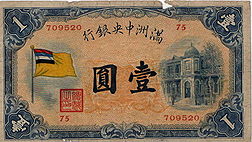- Manchukuo yuan
-
Manchukuo yuan Bank of Manchukuo 1 yuan (1932) User(s)  Manchukuo
ManchukuoSubunit 1/1000 li 1/100 fen 1/10 chiao Coins 5 li, 1, 5 fen, 1 chiao Banknotes 1, 5, 10, 100, 1000 Central bank Central Bank of Manchou This infobox shows the latest status before this currency was rendered obsolete. The Manchukuo yuan (滿洲國圓) was the official unit of currency of the Empire of Manchukuo, from June 1932 - August 1945.
The monetary unit was based on one basic pure silver patron of 23.91 grammes. It replaced the Chinese Haikwan tael, the local monetary system in common and regular use in Manchuria before the Mukden incident, as legal tender.
Contents
History
Initially bank notes and coins were produced minted by the Bank of Japan, but were later issued from the mint of the Central Bank of Manchou in the Manchukuo capital of Hsinking (now Changchun). Due to worldwide fluctuations in the price of silver during the 1930s, Manchukuo took the yuan off the silver standard in 1935 and subsequently pegged the yuan to, and later reached approximate exchange parity with, the Japanese yen. In 1940 the Manchukuo yuan was being used to measure Manchukuo exports and imports to countries that included America,[1] Germany and Japan.[2]
Throughout this period about half the value of the issued notes was backed by specie reserves. The notes issued were in five denominations, one hundred, ten, five and one yuan and five chiao (one-half yuan), and typically depicted Qing dynasty rulers of China on the obverse. To keep up with the inflationary pressures typically experienced by Japanese-controlled areas towards the end of World War II, a 1,000 yuan note was issued in 1944.
The Yuan was subdivided into 10 chiao (角), 100 fen (分) or 1000 li (釐). Coins were issued in denominations of 5 li up to 10 fen.
In 1944 and 1945, Manchukuo issued coins (1 and 5 fen) made of what the "Standard Catalog of World Coins" describes as "red or brown fiber", resembling cardboard. These are a rare example of non-metallic coins.
In 1948, after the end of World War II, approximately 12 billion yuan of Central Bank of Manchou notes were redeemed by the Tung Pei Bank.
Banknotes
 10 Yuan note, 1937 (back), depicting the Central Bank of Manchou headquarters
10 Yuan note, 1937 (back), depicting the Central Bank of Manchou headquarters
See also
References
- ^ Future of American Trade with Manchukuko, Roy H Akagi, 3 June 1940, accessed September 2009
- ^ Germany and republican China, William C. Kirby 1984, p143, accessed September 2009
- Krause, Chester L. and Clifford Mishler (1991). Standard Catalog of World Coins: 1801–1991 (18th ed. ed.). Krause Publications. ISBN 0873411501.
- Pick, Albert (1994). Standard Catalog of World Paper Money: General Issues. Colin R. Bruce II and Neil Shafer (editors) (7th ed.). Krause Publications. ISBN 0-87341-207-9.
Categories:- Currencies of Asia
- Modern obsolete currencies
- Manchukuo
- 1932 establishments
- 1945 disestablishments
Wikimedia Foundation. 2010.





